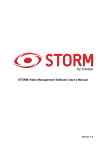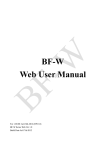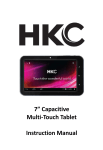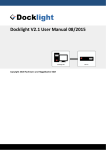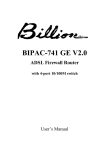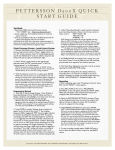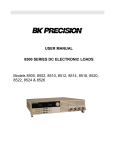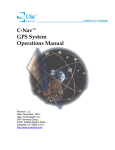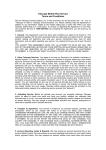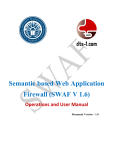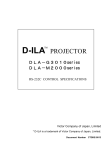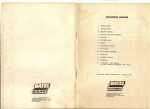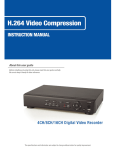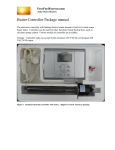Download KS-858E User`s Manual(the las
Transcript
LCD Intelligent Alarm System User's Manual Mar, 2007 Publish Please read this manual carefully before you operate Telephone Network Intelligent Alarm System Table Of Contents Telephone Network Intelligent Alarm System What's included 1.System Introduction ------------------- --------------------------------------------------------------(2) 2.Main Functions -------------------- -------------------------------------------------------------------(2) 3.System Diagram --------------------------------------------------------------------------------------(3) 4.System Installation --------------------------------------------------------------------------------- -(4) 5.Program Guide ---------- ----------------------------------------------------------------------------- (9) Directive 00: Set/modify installer code --------------------------------------------------------------(9) Directive 01-09: Set/modify user code/master code ------------------------------------------------ (10) Directive 10-14: Set telephone number -------------------------------------------------------------- -(10) Directive 15-19: Set zone list to dial corresponding telephone number when alarming ------- (11) Directive 20: Set dialing mode------------------------------------------------------------------------- (12) Directive 21: Set telephone communication protocol ----------------------------------------------- (12) Directive 22: Set dialing times--------------------------------------------------------------------------(12) Directive 23: Set ringing times- ------------------------------------------------------------------------(12) Directive 24: Set ADEMCO accounts------------------------------------------------------------------(12) Directive 25: Set KS 6+2 accounts---------------------------------------------------------------------(12) Directive 26: Set wireless siren -------------------------------------------------------------------------(12) Directive 27: Open/Close phone line cut off report function --------------------------------------(13) Directive 28: Set timing communication zone list --------------------------------------------------- (13) Directive 30: Set zone attribute -------------------------------------------------------------------------(13) Directive 31: Set wired zone respond speed ---------------------------------------------------------- (14) Directive 32: Set circuit type for wired zone - --------------------------- ------------- ---------------(14) Directive 33: Set Alarm delay/Arm delay for appointed zones. -------------------- ---------------(14) Directive 34: Set inner siren alarm duration for appointed zones- ---------------------- ----------(15) Directive 35: Set linkage alarm output duration for appointed zones .--------------------- -------(15) Directive 36: Set the first group of Arm/Disarm timer for zone list --------------------------- ----(15) Directive 37: Set the second group of Arm/Disarm timer for zone list ------------------------- -(16) Directive 38: Correct date and time -------------------------------------------------------------------(16) Directive 41-48: Partition Register---------------------------------------------------------------------(16) Directive 50: Record ---------------- ----------------------------------------------------------------- - - (17) Directive 60: Register/delete remote controllers------------------------------------------------------(17) Directive 71-78: Register/delete detectors ------------------------------------------------------------(17) Directive 80: Come back to default state --------------------------------------------------------------(18) 6.User Operation Guide ------------------- ------------------------------------------------------------(20) 7.Technical Specification---------------- ---------------------------------------------------------------(25) 8.Operate Precautions- ---------------------------------------------------------------------------------(25) 9.Frequently Ask Questions ---------------------------------------------------------------------------- (26) 10. Wireless PIR Detector ------------------------------------------------------------------------------(27) 11. Wireless Door Sensor -------------------------------------------------------------------------------(30) 12.Warning -----------------------------------------------------------------------------------------------(32) .1. 1. Main Unit 1PC 2. Key 2PCS 3. Remote Controller 2PCS 4. Antenna 1PC 5. Power Lead 1PC 6. Double-end Telephone Line 1PC 7. 2.2KΩLine-end Resistance 8PCS 8. Screw 2PCS 9. Selftapping Screw 3PCS 10.Maintenance Card 1PC 11.Users Manual 1PC 12.Plastic Bolt 3PCS 1.System Introduction This system is a Telephone Networking Alarm Console with LED&LCD display, there are 16 zones (8 wireless zones and 8 wired zones). It works with remote controllers (up to 8 remote controllers), various wireless (wired) detectors and wireless (wired) sirens. It can store 5 pre-set telephone numbers (fixed/mobile telephone number and pager number). Once alarm happens, the alarm console will activate on-site siren immediately; and dial pre-set telephone numbers at the same time It is widely used in residence, marketplace, finance system and enterprise. 2.Main Functions: 2.1 It is easy to operate with 4*4 keyboard and lattice LCD display. 2.2 Voice pre-recorded. It guides to operate by sound and correctly reports alarm information when alarming. 2.3 There are 8-wired zones and 8 wireless zones altogether, and they share with the zone number. 2.4 8 sub zones can be programmed independently. And the zone list can be set freely in each sub zone, 8 remote controllers and 8 user's codes can separately program for 8 sub zones to ARM/DISARM independently. 2.5 Code classification, 1 installer code, 1 master code, and 8 common user 's codes. Add 1 at the end of master code/ common user's code, and then it will become duress code. 2.6 Support to ADEMCO CONTACT ID communication protocol 2.7 5 groups of telephone numbers (mobile and pager number) can be set. Dialing type (tone or pulse) and appointed communication zone can be programmed. Arm/disarm, whether to report the information of system state can be set freely. 2.8 DTMF (double-tone multi frequency) and pulse dialing mode are available. 2.9 It rushes to report alarm information when alarming (the line should be correctly connected) 2.10 Telephone line cut off or short-circuit will send an alarm. (Indicate sound or siren are optional, this function also can be opened/closed). 2.11 Dial the telephone number, which connected with main unit to arm/disarm and start alarm on the spot function remotely through telephone or mobile phone. 2.12 Automatically learn code between wireless PIR detector, remote controller and .2. Telephone Network Intelligent Alarm System Telephone Network Intelligent Alarm System Main unit (each zone can be learned up to 3 detectors, so it can be learned up to 24 detectors and 8 remote controllers altogether.) 2.13 Wired zone respond speed is 50ms-750ms, and the circuit types (Normal Open, Normal Close and line-end resistance) can be set freely to connect with all kinds of wired detector. 2.14 Two timers can be set to Arm/Disarm different zones independently. 2.15 Alarm delay time (00-99 seconds) and Arm delay time (00-99 seconds) can be set for appointed zones. 2.16 It has completed self-check function, Main unit/detector disassembly, AC power cut, backup battery lower of main unit and detector will activate alarming. 2.17 Linkage with wired/wireless Siren 2.18 Latest 30 pieces of alarm record (Alarm information, Month/Day/hour/minute) can be recorded, and the user and time of the last arm time and the last disarm time can be recorded. If the records are over 30 pieces, then it will delete the preceding ones automatically. User cannot change/delete the records. 2.19 Main unit and wireless PIR detector make communication in 26 hours to check if there are communication malfunctions. If there are malfunctions, the main unit will alert corresponding zone within 26 hours. (This function can be opened/closed) 2.20 Wireless detector reports to main unit for on/off. The report will be kept in record. 2.21 Both AC220V and 12V/7Ah rechargeable battery supply power, usually, it charges the backup battery automatically, and they switch automatically. The backup battery can work for 24 hours or more in standby time. And it reports when power lower. To avoid battery damaged, it adopts limited current discharge protection circuit. 3.System Diagram Alarm Center Phone Mobile Phone BP Wireless PIR Wired PIR Wireless Door Sensor Wired Door Sensor Monitor On Spot Alarm Console Monitor On Spot Wireless Smoke Detector Wired Smoke Detector Wireless Gas Detector Wired Gas Detector Wired Siren Emergency Button Remote Controller .3. Wireless Siren 4.System Installation Thank you for choosing our products! As you known, any kinds of products, to assure its credibility and fully display all its functions, it should be installed and used correctly. So we recommend installing by professional personnel. Otherwise, we have no responsibility for any malfunctions caused by installing or using incorrectly. Please contact with our local agency if you need our professional personnel! 4.1 Install preparation 1. Firstly, make a scheme of all defense zones according to user¡s needs, and choose suitable kinds of detectors. 2. Fix the setup places of all fittings, like alarm host ,detectors and sirens. 3. Draw a setup map marking the types and specification of detectors and cable conductors in all zones, and marking the different usages of all kinds of color lines. Don¡t use the same color cables in different zones of the same system. (The scheme and the map should be filed for maintenance afterwards) Note: Considering the factors as follows when making defense scheme and drawing the map. *After making sure the credibility of detector, it should be fixed in hide places, and the alarm host should be fixed in a place where is easy to reach but not easy to be found, and there should have sockets nearby, it also should be near to telephone line and within defense zone of detector. Siren or trumpet should be set in the best place. Emergency button should be set in the most convenience place. *When installing wired detector, the cable should be fixed in hide place, like line groove in ceiling. Don¡t use the same color cables in the different zones of the same system. *There should be no big mental or other electrical applicants which can produce interferes (like television ,air-condition,computer and micro-oven and so on) near to the install place of alarm host and other wireless communication equipments. Otherwise, it will affect its normal wireless communication function. *Considering all factors, which could cause interferes when adopting wireless detectors and wireless siren. Usually, in open area, the distance between the above detector, siren and alarm host can reach to 400m. The alarm host should be set indoors. Otherwise, in the course of transmitting, wireless signal may be absorbed or weaken by all equipment material indoors. Moreover, other signals of wireless equipment may make interferes to this transmit signal. Therefore, the transmitting distance is less than 400m when used indoors. 4. How to connect power lead with main unit: After opening the out cover of main unit, you will see three labels near to transformer, that are as following: :Connect it with yellow line of power lead. N: Connect it with brown line of power lead. L: Connect it with blue line of power lead. .4. Telephone Network Intelligent Alarm System Telephone Network Intelligent Alarm System 4.2 Start to install (Connection picture 1) U1 Note:* All fuses should use the same kind of fuse pipe to prevent from fire occurrence * Cut all power sources before maintenance Black Battery Connect Socket Red Volume RW1 RW2 Alarm Fuse Power Auxiliary Fuse J1 Wired zones line-connection Programmable Outputting can refer to picture 2 Interface Anti-tamper Interface Black is cathode Red is anode 18V AC 25 - 40VA 50 / 6 0HZ Red is anode Power-cut replace Power Auxiliary Interface Voltage 10-13.5VDC equipment Current should not beyond 0.75A Black is cathode 12V DC 7AH Sealed lead battery Wired Siren Voltage 10-13.5VDC Current should not beyond 2A User phone Line-connection Box 4.2.1 Machine case installing *Firstly, take out alarm host form packing box, and open the cap with key. *Take out circuit board from machine case to avoid damaging it when fixing machine case. *Make a Pre-mode hole *Mark the install place of nail on the wall where the alarm host will be fixed. *Put the cable through pre-mode hole to fix machine case on the wall. *Return the circuit board and fix it firmly. Note: The nail mounting the alarm console should be fasten and can bear three times of weight of alarm console at least. 4.2.2 Ground connection The alarm host should be connected with ground in order to make anti-lightning strike circuit work normally. 4.2.3 Control line connection of alarm host When connecting, the line should be strictly connected according to the .5. different uses of different color cables. Then spread the line according to the setup map, and lead the cable to the place where the alarm host will be fixed. Then connect the line end with the alarm host. When connecting, the cable end should be bared, and the length of bared should be equal to the connect port where will be inserted. It will cause poor contact if the line inserted is too short; and it will cause short circuit if the line inserted is too long. If more than two lines should be connected with the same end, then the bared line should be twisted firmly, then insert them into the hole. After that, screw the screw cap firmly to bear pulling strength. 4.2.4 AC connection The AC is a transformer with 18V, 25-40 VA 500V60Hz. Connect its secondary with the AC end of alarm host. Don¡t connect its primary with the socket controlled by switch. Don¡t connect it with the circuit with GFI. After connecting all lines, power it on. Note: The alarm host will indicate if the AC line cut off for 8 minutes. When there are something wrong with program system, the alarm host will report that the AC is cut off. And the alarm host also will report that it recovers after recovering for 4 minutes 4.2.5 Backup battery connection To make sure the alarm host will work normally in case the AC is cut off, the alarm host should be connected with storage battery as picture 1. Connecting the red line with the anode, and connecting the black line with the cathode. It will damage the battery if they are wrongly connected ,and it uses 12V 7Ah sealed storage battery. Don¡t use non-recharged battery or non-sealed storage battery. We suggest changing the battery every 3 or 5 years. Note: The alarm host will alarm if the voltage is lower than 10.5V. Moreover, it will indicate if there are something wrong with program system, and when voltage is lower than 8.5V, it will cut off the power supply to protect the battery. Don¡t connect the battery before finishing all lines connection. 4.2.6 Auxiliary to connect with power. SW and C end are interfaces, which can be cut off. It provides equipments, which need to recover the cut off state after alarming, with +12VDC. The representative equipments include glass ¨broken sensor and smoke detector. AUX and C end are interfaces, which cannot be cut off. It can provide wired fitting with +12V/500mA DC power. SW&D C end and AUX&C end are protected by fast thawing fuse (0.75A,3AG) 4.2.7 Siren outputting connection Bell&C is the siren outputting interface. It provides stable 12V DC power when alarming. Fast thawing fuse F1(2A, 3AG) protects the interface circuit. When the current over 2A,then the fuse F1 will melt to cut off the connection between alarm host and signal. Note the polarity before connecting. The anode is connected with the Bell end, and the cathode is connected with the C end as picture1. Note: if the fuse melts, please cut all alarm host power. .6. Telephone Network Intelligent Alarm System After clearing all obstructions, change the fuse, and then power it on. Don¡t change it with large capacity fuse. 4.2.8 Program alliance output connection NC.NO.COM are program alliance outputting interfaces, they can be programmed to control the switch of some electrical equipments when there are alarms in some zones . NC is normal close end. And NO is normal open end, COM is common end. their interfaces can be connected with 1A120V AC/24V DC. If the power of being controlled equipments over interface loads, the current condenser capability should be enlarged to avoid damaging the control main board. 4.2.9 wired zones connection Z1-Z8&C have 8 interfaces connecting with line in wired zones. In zone circuit, Z1-Z8 end is anode, C end is cathode, so when connecting, please pay attention to the polarity of detector alarm output interface, So as not to damage other parts of apparatus. But there is no need to distinguish the polarities when fittings are hand-pressing switch or foot-trampling switch. Every zone circuit can be programmed singly to different circuit types, like ¡normal close¡.¡normal open¡ or ¡line end resistance¡.If it is programmed to be¡normal close¡ or ¡normal open¡, the detector¡s alarm outputting interface can be connected directly with the both ends of zone circuit; If it is programmed to be ¡line end resistance¡, the correspondent zone circuit end should be connected with 2.2KΩ resistance(other zone circuits unused for the moment also should be connected). Connection principles: normal open detector should be connected parallelly with 2.2K resistance; normal close detector should be concatenated with 2.2K resistance ( and the resistance should be as near to detector as possible). In order to avoid zone circuit lines damaged(be cut off or short circuit), you had better program corresponding zone circuit to be ¡line end resistance¡. If both resistance down-lead and out-line are connected with the same interface. They should be twisted and screwed firmly, then inserted into the interface, and screw the nail firmly If resistance down-lead is wire-wrapped and connected with out-lines, it should be soldered after wire-wrapped connection. Moreover, the parts of resistance down-lead should be as short as possible to avoid short circuit by touching with other metals after twisted.When the detector need alarm host to provide power, the anode and cathode of the detector¡s power input interface should be separately connected with SW and C interfaces or AUX and C interfaces. .7. Telephone Network Intelligent Alarm System Picture 2 . Wired zone connection diagram Normal Open End with resistance Connection ends of alarm host AU X +1 2V GN D C Z1 AL ARM Normal Close End with resistance Connection ends of alarm host C AU X TA MPE R +1 2V GN D Connection ends of detector C Z1 AL ARM Normal Open End/ Normal Close End without resistance Connection ends of alarm host C AU X TA MPE R +1 2V GN D Connection ends of detector C Z1 AL ARM C TA MPE R Connection ends of detector 4.2.10 Telephone line connection PHONE is the interface of telephone incoming line. LINE is extension interface. When alarming, in order to make alarm host reporting the alarm information to the manage center and user ,LINE interfaces should be connected with telephone incoming line. Extension and other telecommunication equipments should be connected with PHONE interface. But don¡t oppositely connect with incoming line. They should be connected as picture 1 . 4.2.11 Anti-tamper line connection TAMPER&C is the anti-tamper zone interface. It can be set two switches on the case. One is to avoid opening the cap illegally; the other one is to avoid moving or dissembling the alarm host.The install steps of anti-tamper switch 1.Adjust the anti-tamper switch in the right-under corner of case. As to the switch used to prevent alarm host dissembling, its short-circuit end should be put through the small hole under board of case. As to the switch used to prevent cap opening, short-circuit end should be put to outer case. 2.Concatenate both anti-tamper switches, then connect the line end with TAMPER&C interface. 4.3 System Debugging Firstly, check if all lines are correctly connected, next, connect with battery, and cover the case cap. Then connect with AC power to program. Lastly, test system to check if all detector fittings can work normally and can communicate normally with alarm host or if the alarm host can correctly perform all alarm functions.Then the system installation is finished. .8. Telephone Network Intelligent Alarm System Telephone Network Intelligent Alarm System 5. Program Guide 5.1Program 1). Program mode [SET] + [CODE] + [OK] + [Program Directive ] + [OK] + [Directive Index ] + [OK] + [Reset] Note: [SET] + [CODE] + [OK ]is used to enter program state. [SET] + [Installer¡s Code] + [OK ]is used to enter installer program state. [SET] + [Master¡s Code ] + [OK] is used to enter users program state. 2). The system can enter program state only in disarm state and can not receive any alarm signals (including low power supplied of main unit). 3). In program state, it can¡t receive any alarm signals. 4). Press ¡Reset¡ key can erase the latest inputs. Repeatedly press ¡Reset¡ key to return to the last menu. 5). If there are not any operations within 60 seconds in program state, the system will exit automatically. 6). Press ¡Reset¡key to scroll wanted program, or press corresponding program indicative directly. 7). In program state, the system can be programmed continuously. 8). In program state, if you desire to change one Program Directive to the other one, you should press ¡Reset¡ key ,then enter wanted directive. 5.2 Program instruction Enter program state Panel is in standby state (or repeatedly press ¡Reset¡ key to set panel in standby state). Press [SET] key, the panel will indicate with ¡Please Enter Code¡. LCD display will show as picture 3. You are allowed to enter Installer Code or Master Code. Then press [OK] key. ¡Bi¡Bi¡¡means setup correctly, and enter program state. LCD display show as picture 4. If the code you entered is incorrect, it will indicate with ¡The code is incorrect, please re-enter¡. LCD display will show as picture 3. If wrong code is entered three times continuously, the panel will occur on-site alarm and keyboard will be locked for one minute automatically. C Picture 3 Picture 4 Directive 00: Set/modify installer code In installer program state, Press[00] + [OK] . LCD display will show as picture 5. Enter[new code 6 digits] + [new code 6 digits] + [ OK ]. ¡Bi¡Bi¡¡means setup correctly. The LCD display will show as picture 6. Press ¡Reset¡key for more programs. For instance, if you want to change installer code to be ¡123456¡. Please press [00][+] [OK] [+[123456][+] [123456][ +] [OK] Installer Code default is ¡000000¡ .9. C00 000000 C00 123456 Picture 5 Picture 6 Directive 01-09: Set/modify user¡s code/master code In installer or master program state: Press[01]+[OK]+[users code 4 digits]+[users code 4 digits]+[OK] to set the 1st user code Press[02]+[OK]+[users code 4 digits]+[users code 4 digits]+[OK] to set the 2nd user code Press[03]+[OK]+[users code 4 digits]+[users code 4 digits]+[OK] to set the 3rd user code Press[04]+[OK]+[users code 4 digits]+[users code 4 digits]+[OK] to set the 4th user code Press[05]+[OK]+[users code 4 digits]+[users code 4 digits]+[OK] to set the 5th user code Press[06]+[OK]+[users code 4 digits]+[users code 4 digits]+[OK] to set the 6th user code Press[07]+[OK]+[users code 4 digits]+[users code 4 digits]+[OK] to set the 7th user code Press[08]+[OK]+[users code 4 digits]+[users code 4 digits]+[OK] to set the 8th user code Press[09]+[OK]+[master code 4 digits]+[master code 4 digits]+ [OK] to set master code For instance, set the new code ¡5678¡ to be the second user code. Enter installer or master program state: Press [02]+[OK]+[5678]+[5678]+[OK] The LCD display will show as below. C02 5678 Picture 7 Note: 1: User¡s code can not set to be the same, and also can not be the same as other duress code. 2: Press ¡#¡ after directive to delete user code For instance, you want to delete the 8th user code In installer or master program state, Press [08]+[OK] +[#]+[OK] 3: 1-8 user's codes and 1-8 remote controllers are defined to used by 1-8 users, and different users can operate corresponding zone independently. 1234 is master's code and there is no user's code by default. Directive 10-14: Set telephone numbers In installer program state Press [10]+[OK]+[Phone NO.]+[OK]to set the 1st stored phone number Press Note:[11]+[OK]+[Phone NO.]+[OK]to set the 2nd stored phone number Press [12]+[OK]+[Phone NO.]+[OK]to set the 3rd stored phone number Press [13]+[OK]+[Phone NO.]+[OK]to set the 4th stored phone number Press [14]+[OK]+[Phone NO.]+[OK]to set the 5th stored phone number Press a ¡*¡ for 3 seconds to pause dialing. It is used for extension number and semi-pager station. For instance, stored phone number 2532182*804. It means dial 2532182 first, and stop for 3 seconds, then dial 804. .10. Telephone Network Intelligent Alarm System 2.Press ¡#¡ to delete the appointed stored number. For instance, only press [11]+[OK] +[#] +[OK] to delete the second phone number. 3.Each stored phone (including *) should not beyond 20 digits. 4.For wrong stored phone numbers, they can be reentered directly. Or delete the wrong ones, and then enter the right number. For instance, to set the second phone number 2532182, and the extension number is 804. In installer program state Press[11]+[OK]+[2532182*804]+[OK] LCD display will show as below C11 2532182*804 Picture 8 No stored phone numbers by default Directive 15-19: Set zone list to dial corresponding telephone number when alarming How to set self-test report function In installer program state Press[15]+[OK]+[appointed zone No.]+[OK]to set appointed zones to dial the 1st stored phone number. Press[16]+[OK]+[appointed zone No.]+[OK]to set appointed zones to dial the 2nd stored phone number Press[17]+[OK]+[appointed zone No.]+[OK]to set appointed zones to dial the 3rd stored phone number Press[18]+[OK]+[appointed zone No.]+[OK]to set appointed zones to dial the 4th stored phone number Press[19]+[OK]+[appointed zone No.]+[OK]to set appointed zones to dial the 5th stored phone number Note: The alarm console also can inform for Arm/Disarm and malfunction inspection. Code 9 is for Arm/Disarm. Code 10 is for malfunction inspection. (Malfunction inspection includes backup power lower of main unit/detector, AC power cut off). Enter [SET 0]for 10. It will show on LCD. For instance, you want to set zone 1, 3, 5, 7 to dial the first stored phone number when there are alarm occur. you can set as follows: In installer program state Press[15]+[OK]+[1, 3, 5, 7]+[OK] LCD display will show as below C15 13 5 7 Picture 9 You want to set 2, 4, 6, 8 zones. when those zones occurs alarm or Armed/Disarmed and panel malfunction inspection report, it will dial the second stored phone number automatically. In installer program state Press[16]+[OK]+[2, 4, 6, 8, 9, SET 0]+[OK] LCD display will show as below 2 C16 4 6 8 9A Picture 10 .11. Telephone Network Intelligent Alarm System In Ex-factory state, all zones dial all phone numbers except for Arm/Disarm and malfunction inspection. Directive 20: Set dialing mode In installer program state, Press[20]+[OK]+[0 or 1]+[OK], 0 for tone, 1 for pulse. Tone is set by default Directive 21: Set telephone communication protocol In installer program state Press[21]+[OK]+[x x x x x]+[OK], x= (0, 1), 0 for audio alarm, 1 for CONTACT ID protocol alarm. x x x x x is protocols for 5 stored phone numbers. For instance, the first and the second stored number for CONTACT ID protocol alarm, the third, forth and fifth stored number for audio alarm.In installer program state Press[21]+[OK]+[1 1 0 0 0]+[OK] LCD display will show as below C21 1 1 0 0 0 Picture 11 All stored phone numbers are set to be audio alarm by default Directive 22: Set dialing times In installer program state, Press[22]+[OK] +[x]+[OK] , x= (1-9) Note: The dialing times is for alarm phone which wasn¡t received successfully In Ex-factory state, it has been set to be 5 times. Directive 23: Set ringing times In installer program state Press[23]+[OK]+[x x]+[OK], x x= (05-15) Note: alarm panel receives a remote call, when the ringing times arrive, the panel will enter program state , then you can set remotely. In Ex-factory state, it has been set to be 8 times. Directive 24: Set ADEMCO accounts In installer program state, Press[24]+[OK]+[Account 4 digits]+[OK] Note: When networking with ADEMCO center, the code should be 4 bits (0000-9999) Directive 25: Set KS 6+2 Accounts In installer program state, Press[25]+[OK]+[code 6 digits]+[OK] Note: When networking with KS 6+2 center, the code should be 6 bits (this function have not opened at the moment. Directive 26: Set wireless siren .12. Telephone Network Intelligent Alarm System In installer program state, press[26]+[OK]+[wireless siren code 8 digits]+[OK] Note: The 8 digits siren code is marked at the back of siren if you want to erase siren code, in installer program state, Press [26]+[OK]+[#]+[OK] No wireless siren code by default Directive 27: Open/Close phone line -cutting report function In installer program state, Press[27]+[OK]+[0 or 1]+[OK].0 for close report, 1 for open report. Close report by default Directive 28: Set timing communication zones In installer program state, Press[28]+[OK]+[zones 1-8]+[OK] For instance, you want to set 1, 2, 3, 4 zones to send a timing report to the main unit. In installer program state, Press[28]+[OK] +[#]+[OK] to close timing communication. No timing communication by default Directive 30: Set zone attribute In installer program state, Press[30]+[OK]+[xxxxxxxx]+[OK], x is zone attribute of each zone. 8x is for 8 zones X value scale ,you can see attributor table below Note: 1.Zone attribute depends on detector types. 2.Fire alarm, Gas alarm, Emergency alarm and Medical alarm are treated as 24 hours per day. It is out of control by Arm/Disarm. 3.Vacant zone or unused zone can be bypass. 4.The zone attribute number should be 8 digits 5.If zones are set to doorbell zone in attribute, it is only for door alert, no alarm and can¡t dial stored phone numbers. All zones attribute are set to be Intrusion Alarm by default. Attribute table Code Zone Attribute 0 Bypass 1 Fire Alarm 2 Gas Alarm 3 Emergency Alarm 4 Medical Alarm 5 Intrusion Alarm 6 Perimeter 7 Door-bell .13. Telephone Network Intelligent Alarm System Directive 31: Set wired zone respond speed In installer program state, Press[31]+[OK]+[xxxxxxxx]+[OK]. X is zone speed for 1 to 8 zones.X value table below Code Wired zone respond speed 1 50ms 2 (default) 100ms 3 250ms 4 500ms 5 750ms 100m for all wired zones by default Directive 32: Set wired zone type In installer program state, Press[32]+[OK]+[xxxxxxxx]+[OK], X is wired zoned type for zone 1 to 8.X value see table below Wired zone type Normal Open Noemal Close End of line Resistance Code Name 1 2 3 Note: If you select zone type of end of line resistance, for N/O (Normal Open) device, you have to connect with a parallel-connection 2.2k resistance. For N/C (Normal Close), you have to concatenate with a 2.2k resistance in series.. (end of line resistance type is recommended for all zones.) N/C type for all zones by default Directive 33: Set Alarm delay/Arm delay for appointed zones. In installer program state, Press[33]+[OK]+[Alarm delay time][Arm delay time][appointed zones 1-8]+[OK] Alarm delay time range: 00-99 seconds (2 digits) Arm delay time range: 00-99 seconds (2 digits) Zone number range : 1.2.3¡¡8 For instance, if you desire to set zone 1.3.5.7 for alarm delay and arm delay, alarm delay time is 30 seconds; arm delay time is 50 seconds In installer program state, Press [33]+[OK]+[30][50][1 3 5 7]+[OK]. The screen will show as below: C33 3 0 5 0 13 5 7 Picture 12 .14. Telephone Network Intelligent Alarm System No alarm delay time and arm delay time by default Directive 34: Set inner siren alarm duration for appointed zones In installer program state, press [34]+[yy] [xx...xxx]+[OK], x means zone number which ranges from 1 to 8, and 9 (telephone line malfunction). The number of ¡x¡ should be 9 st mot, yy=903-99), which is siren alarm output duration (minute). For instance, If you desire to set zone 2.4.6 and phone line malfunction, built-in siren duration is 30 minutes when it alarms, In installer program state, Press[34]+[OK]+[30][2 4 6 9]+[OK] The screen will show as below. C34 30 246 9 Picture 13 Inner siren duration 20 minutes for all zones by default No built-in siren for phone line broken by default Note: The emergency alarm duration of remote controller and anti-tamper alarm duration of detector are unlimited by the time. Directive 35: Set linkage alarm output duration for appointed zones. In installer program state, press[35]+[OK]+[linkage alarm duration][appointed zones.]+[OK] Linkage alarm duration range: 00-99 minutes (2 digits) Zone number range: 1.2.3¡¡9 (9 is for phone line malfunction) For instance, If you desire to set zone 2.4.6 and phone line malfunction when it alarms, Linkage alarm siren duration is 30 minutes. In installer program state, press[35]+[OK]+[30][2 4 6 8 9]+[OK] The screen will show as below. C35 30 246 9 Picture 14 Linkage alarm duration 20 minutes for all zones by default, No linkage alarm for phone line malfunction by default Note: The emergency alarm duration of remote controller and anti-tamper alarm duration of detector are unlimited by the time. Directive 36: Set the first timer of Arm/Disarm In installer program or in master program state , Press[36]+[OK]+[Arm time][Disarm time][partition No.]+[OK] Arm time is 4 digits, 2 digits for hour, 2 digits for minute Disarm time is 4 digits, 2 digits for hour, 2 digits for minute Partition number is 1.2¡¡9. (9 is for all partitions) For instance, if you desire to arm at 08:00pm, and disarm at 18:00pm for all partitions automatically. In installer program state for all partitions, Press[36]+[OK]+[0800][1800][9]+[OK]. The screen will show as below. .15. Telephone Network Intelligent Alarm System C36 0 8 0 0 18 0 0 9 Picture 15 Press[36]+[OK]+[#]+[OK]to delete the first timer. Directive 37: Set the second timer for Arm/Disarm In installer or master program state , Press[37]+[OK]+[Arm time][Disarm time][partition No.]+[OK] Arm time is 4 digits, 2 digits for hour, 2 digits for minute Disarm time is 4 digits, 2 digits for hour, 2 digits for minute Partition number is 1.2¡¡9. (9 is for all partitions) For instance, if you desire to arm at 18:20pm, and disarm at 07:40 am next morning for partition 1, 2 automatically. In installer program state for all partitions, Press[37]+[OK]+[1820][0740][1 2]+[OK]. The screen will show as below. C 37 18 2 0 0 7 4 0 12 Picture 16 Press[37]+[OK]+[#]+[OK]to delete the second timer. No timer for Arm/Disarm by default Directive 38: Correct Date and Time In installer or master program state, Press[38]+[OK]+[month][date][hour][minutes]+[OK] Two digits are for month, date, hour and minutes each. Directive 41-48: Partition Register In installer program state, Press[41]+[OK]+[appointed zone No.]+[OK]for the 1st partition Press[42]+[OK]+[appointed zone No.]+[OK]for the 2nd partition Press[43]+[OK]+[appointed zone No.]+[OK]for the 3rd partition Press[44]+[OK]+[appointed zone No.]+[OK]for the4th partition Press[45]+[OK]+[appointed zone No.]+[OK]for the 5th partition Press[46]+[OK]+[appointed zone No.]+[OK]for the 6th partition Press[47]+[OK]+[appointed zone No.]+[OK]for the 7th partition Press[48]+[OK]+[appointed zone No.]+[OK]for the 8th partition Zone number is 1, 2, 3,¡¡8 Note: 1.Each zone can be repeatedly registered in different partitions. 2.Delete partitions Press[41]+[OK]+[#]+[OK]to delete the 1st partition Press[42]+[OK]+[#]+[OK]to delete the 2nd partition Press[43]+[OK]+[#]+[OK]to delete the 3rd partition Press[44]+[OK]+[#]+[OK]to delete the 4th partition Press[45]+[OK]+[#]+[OK]to delete the 5th partition Press[46]+[OK]+[#]+[OK]to delete the 6th partition .16. Telephone Network Intelligent Alarm System Press[47]+[OK]+[#]+[OK]to delete the 7th partition Press[48]+[OK]+[#]+[OK]to delete the 8th partition For instance, you appointed zone 1, 3, 5, 7 to register in the first partition. In installer or master program state , Press[41]+[OK]+[1, 3, 5, 7]+[OK]for the 1st partition The screen display will show as below. C41 13 5 7 Picture 17 3.1-8 user's codes and 1-8 remote controllers are defined to be 1-8 users, and different users can operate corresponding zone independently Directive 50: Record your message In installer program state, Press[50]+[OK]to enter the record menu, and press[0]+[OK]to start record message for 10 seconds. Close microphone to record and press [OK] to finish. Press[1]+[OK] to display record message. In record menu, press[0]+[OK]to record repeatedly. Directive 60: Register/delete remote controller In installer program state, Press[60]+[OK]to enter register remote controller menu, and enter code number 1 to 8 for corresponding remote controller and [OK] key to confirm. In remote controller registering menu. Press[1]+[OK]to register the 1st remote controller Press[2]+[OK]to register the 2nd remote controller Up to 8 remote controllers If the code is vacant, the screen will show as picture18 , if the code has been registered, It will show as Picture19 Register a remote controller in vacant code, press Arm key on remote controller, ¡Bi-Bi-¡ indicate register successfully. If the code have been registered, there is a ¡Di¡¡ indicative alert ,in that menu, Press[#]+[OK]to delete the original register firstly, then register it the same as vacant code. Press[1]+[OK]+[#]+[OK]to delete the 1st remote controller Press[2]+[OK]+[#]+[OK]to delete the 2nd remote controller Up to 8 remote controllers In installer program state, Press[69]+[OK]+[#]+[OK]to delete all registered remote controllers. C60 C60 Picture 18 A C 9 0 A B Picture 19 Note: 1: when learning remote controller, main unit will recognize automatically to see if this code has been learned, if this remote controller has been learned, Then the main unit will refuse to learn this code, and it will make a ¡Di...¡ Sound. 2: After learning, you should test to see if this code has been learned successfully. .17. Telephone Network Intelligent Alarm System 3: 1-8 remote controller and 1-8 user¡s code are defined to be 1-8 users, and they can separately operate in 1-8 sub zones. Directive 71-78: Register/delete sensors In installer program state, Press[71]+[OK]to enter the1st zone register. Press[1]+[OK]to register the 1st sensor Press[2]+[OK]to register the 2nd sensor Press[3]+[OK]to register the 3rd sensor Press[72]+[OK]to enter the 2nd zone register. Press[1]+[OK]to register the 1st sensor Press[2]+[OK]to register the 2nd sensor Press[3]+[OK]to register the 3rd sensor ¡¡ Up to 8 zone registers For instance, register the third sensor in the second zone. In installer program state, Press[72]+[OK]to enter the second zone sensor register. Press[3]+[OK]to enter the third code. Picture20 for vacant code, Picture21 for registered code. C72 C72 1357BC Picture 20 Picture 21 Register a sensor in vacant code, trigger sensor to send a signal to alarm console, Bi-Bi-means register successfully. If the code has been registered, you have to delete it before registering new sensor. Press[#]+[OK]to delete previous registered, then register it the same as vacant code. In installer program state, Press[79]+[OK]+[#]+[OK]to delete all registered sensors. Press[71]+[OK]+ to enter the 1st zone register. Press[1]+[OK]+[#]+[OK]to delete the 1st sensor Press[2]+[OK]+[#]+[OK]to register the 2nd sensor Press[3]+[OK]+[#]+[OK]to delete the3rd sensor Press[72]+[OK]to enter the 2nd zone register. Press[1]+[OK]+[#]+[OK]to delete the 1st sensor Press[2]+[OK]+[#]+[OK]to delete the 2nd sensor Press[3]+[OK]+[#]+[OK]to delete the 3rd sensor ¡¡ Directive 80: Come Back To Default State. In installer program state, Press[80]+[OK]+[#]+[OK], the alarm console will come back to default state. 5.3 Program Table Note: Both installer code and master code can be programmed for those marked ¡*¡ in remark column. Others have to be programmed by installer code .18. Telephone Network Intelligent Alarm System Telephone Network Intelligent Alarm System installer code. Program Directive Definition Default 00 Modify installer code 000000 st Users memo Remark 01 Set/delete 1 user code No * 02 Set/delete 2nd user code No * 03 Set/delete 3rd user code No * No No * * 04 05 th Set/delete 4 user code Set/delete 5th user code th 06 07 Set/delete 6 user code Set/delete 7th user code No No * * 08 09 Set/delete 8th ser code Modify master code No 1234 * * 10 Set/delete 1st stored phone number No 11 12 13 nd Set/delete 2 stored phone number Set/delete 3rd stored phone number Set/delete 4th stored phone number No No No th Program Directive Definition Default 41 Set/delete 1st partition for appointed zones nd Set/delete 2 partition for appointed zones Set/delete 3rd partition for appointed zones 12345678 12345678 44 45 Set/delete 4th partition for appointed zones Set/delete 5th partition for appointed zones 12345678 12345678 46 Set/delete 6th partition for appointed zones 12345678 47 Set/delete 7th partition for appointed zones 12345678 48 Set/delete 8 partition for appointed zones 12345678 50 Record message No 60 69 Register/delete remote controller Delete all register remote controllers No 71 Register/delete sensor in 1st zone No Register/delete sensor in 2nd zone No 14 15 Set/delete 5 stored phone number Set/delete 1st stored phone number for appointed zones No 12345678 72 73 Register/delete sensor in 3 zone No 16 Set/delete 2nd stored phone number for appointed zones 12345678 74 Register/delete sensor in 4th zone No rd rd th 17 Set/delete 3 stored phone number for appointed zones 12345678 75 Register/delete sensor in 5 one No 18 19 Set/delete 4th stored phone number for appointed zones Set/delete 5th stored phone number for appointed zones 12345678 12345678 76 77 78 Register/delete sensor in 6th one Register/delete sensor in 7th zone Register/delete sensor in 8th zone No No No 20 Set dialing type 0 (tone) 79 Delete all registered sensor 21 22 Set telephone communication protocol Set dialing times 00000 5 80 Come back to default 23 Set ring times 8 24 Set ADEMCO account No 25 26 Set KS 6+2 account Set wireless siren No No 27 28 Open/close phone line cut report Set timing communication zones 01(close) 30 Set zone attribute 55555555 31 Set wired zone response speed 22222222 32 33 Set wiring type Set alarm delay/Arm delay for appointed zones 11111111 33333333 34 Set inner siren duration for appointed zone 2012345678 35 Set linkage alarm output for appointed zones 2012345678 36 37 Set 1st timer for Arm/Disarm Set 2nd timer for Arm/Disarm No No 38 Correct Date and Time 6.Users Operation Guide No No * * * .19. Remark 12345678 42 43 th Users memo 6.1 Panel Instruction 1). LED indicator 1 to 8 zone indicators are for wireless zones. All zone indicators are off in normal state. The zone indicator is on when it detects alarm signals. The zone indicator will be flashing once every 4-second when it is in arm state.. PWR (Power) indicator ( red), Power indicator is red when AC supplier is normal. Power indicator is off when AC supplier cut-off. RUN indicator ( red), the indicator is on for a second when it is powered on. And be flashing once every 4 seconds. Arm indicator ( red), the indicator is on for a second when panel accept arm order. Otherwise, it is off when panel receive disarm order. .20. Telephone Network Intelligent Alarm System Emergency indicator ( red), It is on when an emergency alarm occurs by pressing Emergency key on remote controller. It is off when the system is disarmed. LCD MIC Keyboard 运行 交流 布防 紧急 Z1 Z2 Z3 Z4 Z5 Z6 Z7 Z8 Telephone Network Intelligent Alarm System 4). Display content definition. Display content Definition Display content Definition Arm Arm Disarm Disarm TEL Error Telephone failure TEL Back Telephone line come back to normal AC Loss AC power cut-off AC Back AC power come back to normal MBAT Low Main unit power low MBAT Back Main unit battery come back to normal Sensor in x zone power low Zx L (x=1-8) Back X zone sensor power come back to normal Zx Fire (x=1¡ 8) Fire alarm in x zone Zx Gas (x=1¡ 8) Gas leakage in x zone Zx EMC (x=1¡ 8) Emergency alarm in x zone Zx (x=1¡ 8) Medical Medical alarm in x zone Zx Theft (x=1¡ 8) Intrusion alarm in x zone Zx (x=1¡ 8) Zx Tamper (x=1¡ 8) Tamper alarm in x zone Zx Com (x=1¡ 8) Zx Open (x=1-8) X zone open infrared sensor Zx Close (x=1-8) X close the infrared sensor Zx (x=1¡ 8) Emergency alarm in x user Ux Duress (x=1¡ 8) Duress alarm in x user 设防 1 2 3 4 5 6 编程 7 8 9 确认 * 0 # 复位 line LED Indicator Box Lock battery Speaker Panel of alarm host diagram 2). LCD display Two lines for LCD display, up-line is for time and 3 characters, down-line is for 11 characters display. After powered on ,it inspectsautomatically, and the LCD display is for initialization (see picture 22) Welcome Picture 22 Read alarm information on screen when system occurs alarm. For instance, a fire alarm in the 8th zone (see picture 23below). N01 Z 0 8 F i r e Picture 23 Zx (x=1¡ 8) Low EMC Host Tamper Alarm time ¡ September 15th , 11:38¡ ¡N01¡ is the first alarm record. ¡Z08¡ is the 8th zone Fire means fire alarm. The screen can be scrolled for more alarm records, ( scrolling once every 5 seconds) 3). Remote controller is Arm key is Disarm key is Emergency key, on-site alarm will be activated and dial all stored phones by pressing emergency alarm. .21. Antenna Indicator Arm Disarm Emergency KS-12A Remote Controller Main unit alarm Peri Perimeter alarm in x zone err Communication failure in x zone tamper 5). Sound indicator Indicator Definition A short ¡ Bi-¡ Valid indicator for keyboard indicator Two short ¡ Bi-Bi-¡ Program operation correctly or arm indicator Four short ¡ Bi-Bi-Bi-Bi-¡ Power on inspect--self or disarm indicator A long ¡Di----¡ The wrong program indicator A short ¡ Di-¡ every second Phone line failure indicator A short ¡ Bi-¡ every two second S Delay arm alert indicator A short ¡ Di-¡ every two second S Delay alarm alert indicator A long ¡Bi----¡ every 1 minutes Main unit battery low indicator .22. Telephone Network Intelligent Alarm System 6.2 Code 1)The installer code: It is used to set alarm console. Default code is ¡000000¡. 2)Master code: It is used to Arm/Disarm/ modify user code/ correct date and Arm/Disarm timer. Default code is ¡1234¡. 3)User code: system can be programmed up to 8 user codes (no user code by default). With user code to Arm/Disarm corresponding partition. 4)Duress code. It is composed of last digit of user code plus 1, (for example, the user code is ¡1234¡. The duress code is ¡1235¡). If the last digit of user code is 9, the last digit of duress code shall be 0 (for example, the user code is 1239. the duress code is 1230). The user code is used when users are in duress. The users can cancel alarm and disarm system by duress code, but the system also send out the alarm information through telephone to ask for help at the same time. 6.3 Arm/Disarm 1). The remote controller programmed to arm/disarm for different partitions. Press key to Arm, Press key to disarm. 2) Arm/disarm for different partitions on panel keyboard. Quick Arm, the partition is in disarm state, press partition number and SET key. For example, you want to quickly arm partition 8 (partition 8 is in disarm state), just press 8 and ¡SET¡ key on panel keyboard. ,Then the partition 8 is armed. Note: you can arm all partitions by pressing ¡8¡,if the pa rtition you choose is in arm state, the indicate ¡enter the code¡ Routine Operations: In standby time, press ¡set¡key,it will indicate that ¡please enter code¡,then press [4 digits user code ]+[OK ].If the code you entered is the same as the preset user code, it will enter disarm state, oppositely, it will enter arm state. If the code is wrong, it will indicate that ¡The code is wrong ,please re-enter the code¡. If the code you entered is wrong for three times continuously, it will alarm on spot and lock the keypad for 1 minute. Note: Different user code only can operate the corresponding zones. If you operate by entering master code, press [4 digits master code ]+[partition No] to arm/disarm the different partitions. If the partition No is ¡9¡ or you don¡t enter any No, that means you arm/disarm all partitions. 3). Arm/Disarm through timer. 4). Arm/Disarm through remote telephone with user code or master code. Note: the user code Arm/Disarm is only for corresponding partition. Master coder is for all partitions Note: During Arm operation, the sound ¡Bi- Bi-¡means Arm, the Arm indicator light will be on and the corresponding zone will enter arm state. For the delay Arm zones, the panel won¡t enter arm state until delay time expired. During the delay time ,there is a sound ¡Bi-¡ very two seconds to alert users to leave before delay time arrive. 6.4 Alarm operation 1). Intrusion alarm The zone attribute in ¡Intrude Alarm or Perimeter alarm¡, They won¡t activate until alarm console in Arm state. So don¡t forget to ARM the alarm system .23. Telephone Network Intelligent Alarm System before you leave the place. 2) Emergency Alarm Press key for emergency help in urgent situation, the alarm activate by emergency key will dial all stored phone numbers and start on-site siren. 3) Duress alarm When you are in dress by robber, press the duress code. The alarm system will be disarmed, but send duress information through phone dialer. Note: If your system setup is in delay alarm state, the duress alarm will delay. During the time ,the console will be Di- Di- every two seconds. You can Disarm system. 6.5 When you receive alarm 1)ADEMCO alarm center processing automatically 2)Users processing When alarm console dials the phone number you set . It plays the recorded message your stored. And give you 5 seconds after displaying message. During 5 seconds, you are able to press 5#.4#.2# or 0# on your phone or mobile phone. Press 5# to display message you stored repeatedly. Press 4# to listen to 30 seconds sound from alarm console location. During the time, any operation is ineffective. You are able to enter other commands (see appendix 4) after 30 seconds. If there are not any operations in 30 seconds, the system will dial next phone number your set . Press 2# to deactivate alarm and disarm the alarm console. It will not dial other phone numbers you stored any more. Press 0# to exit this call, and dial next phone number your stored. But system will dial this number later in turn. If you receive call from alarm console and no do any operations. It will display message 5 times repeatedly and dial next phone number. Message format: ¡Ding-Dong, please attention!![Message you record], zone number and alarm attribute¡. 6.6 Remote setup You are able to dial phone numbers that alarm console located through your phone or mobile phone. When the ring times you set arrives, the alarm console will indicate that ¡Please enter code ¡, then you have to ent er user code and # on your phone keyboard. (If no operation beyond 5 seconds, there is another indicator ¡Please enter code¡. It will repeat three times and then hang up.) One sound indicator ¡Du-¡ means the code is correct. Then you are able to enter directive you wanted. If no operation beyond 30 seconds, the phone will be hung up. If incorrect code was entered three times continuously, the phone will be hung up. You also be able to press 4# to listen to 30 seconds sound from alarm .24. Appendix 4 Directive Definition Command Definition 1# Arm 2# Disarm 3# 6# Start up on-site siren Start up linkage device 4# 7# Listen to on-site sound Shut down linkage device 8# Shut down on-site siren 0# exit 6.7 Record Inquiry 1)In standby time, press[1]+[OK]to read the latest Arm record, LCD display will show as below. The time is the latest arm time. ¡U02¡tell you that it is armed by the second user. 2)In standby time, press[2]+[OK]to read the latest Disarm record, LCD display will show as below. The time is the latest disarm time. ¡U02¡tell you that it is disarmed by the second user. 3)In standby time, press[3]+[OK]to quickly read alarm record up to 20 pieces, and press[*]or[#]for up or down pager 7.1 Alarm Console Size:26.4cm X 26cm X 8cm (LXWXH) Excluding length of antenna Weight:3KG (Excluding backup battery) Power Supply:AC220V¡15%, Battey:12V/7Ah Auxiliary Output Power: <550mA Siren Output Current: < 1.5A Total Output Current: ≤1.5A (the current of outer current should not over it) Wireless Working Frequency:433MHz Wireless Communication Distance: The distance between PIR detector and alarm host (in open area ≥400m) ≥200m) ( ≥ ) 0℃-55℃ 40-70% 7.2 ≤10mw ≤5uA 433MHz Telephone Network Intelligent Alarm System 1. connect both 3. wrongly negative terminal and signal terminal for the zone that is not sensor connected. For the zones where have not sensor connected are asked to connect signal terminal correctly or bypass them. Communication failure while alarming or dialing Telephone communication protocol is not programmed. Program the telecommunication protocol rightly The telephone can not dial while alarming The telephone line and out line are connected oppositely. Correct the telephone hole and line hole . Telephone Network Intelligent Alarm System 2. Technical Parameter 1.Detective distance ≤8m 2.Detective angle: 90¡ 3.Working Voltage: DC6V (4pcs No.7 dry batteries), and external power (adapter):DC9V~12V. 4.Working Current: Power supplied by battery, Standard current≤50μA, Alarm currenct≤15mA Power supplied by the adapter, Standard current≤5mA, Alarm currenct≤15mA 5.Blocked time when it is power on:100seconds 6.Emission time: 3 seconds 7.Emission Frequency: 4333.92 MHz 8.Emission power≤70mW 9.Physical size: 110mm X 60mm X 45mm 10.Working temperature:-25℃~+65℃ 3. Component Description Wireless Infrared Sensor User¡s Manual Wireless Passive Infrared Sensor adopts advanced digit signal processing. It is with automatic temperature compensation technology, Lower power alert and timing communication report. It detects human infrared heat energy to emit wireless digit signals to activate alarm host. It is advantage of low false alarm rate , stable and easy installation. 1. Main Functions And Features 1.Adopt dual infrared sensor, high sensitivity. 2.Single-chip intelligent digit processing 3.Double-channel intelligent signal processing 4.Low power consumption design, static current≤50¦A, anti-pet, anti-electromagnetism interference and low false alarm rate . 5.Three levels of sensitivity. 6.Automatic temperature compensation 7.Adapter DC9V-12V is available. Automatically switch between inner power and external power. 8.With power lower alert and send signal to alarm host to report. 9.Timing communication report and ON/OFF report. .27. 3.1 Working Mode: There are three Modes of Switch¡Testing Mode, Standard Mode, Power Saving mode. A.Test Mode: After it sends a signal, the sensor won¡t send a new signal until 5 seconds. It is recommended to debug. This mode run more power. B.Standard Mode: After it sends a signal, the sensor won¡t send a new signal until 60 seconds. It is recommended to work daily. C.Power Saving Mode: After it sends a signal, the sensor won¡t send a new signal until 240 seconds. It is used in marketing place where have more people in and out. Note: The mode shall be changed in power off state (including batteries power). 3.2 Tamper: When DOS is opened or destroyed illegally, infrared detector will send signals to alarm host and activate alarming. Tamper alarm can be activated in 24 hours a day. Even the sensor is in power off state. .28. Telephone Network Intelligent Alarm System Telephone Network Intelligent Alarm System 3.3 Power on/off: Adjust switch to ¡ON¡ position, the detector will start to work, adjust switch to¡OFF¡ position, the detector will stop working and report to the host at the same time. 3.4 External DC Input: DC9V~12V is available (polarity **), External power supplied and inner power supplied can be changed automatically. 4. Installation Requirements And Diagram 4.1. Installation Requirements 4.1.1 The infrared detector has the highest sensitivity when a human body moves parallel with the mirror surface and the sensitivity is the lowest when a human body moves vertically against the mirror surface. So the angle and height against the horizontal surface should be noted during installation, which will greatly effect the range of the defense area. The height shall be 2 meters or so and the angle against the wall should be parallel.. 4.1.2 Stand off sunshine and other break-out light sources (e.g. car light) 4.1.3 Stand off the warm or cold sources, e.g., warm air or cold air outlet, air conditioning outlet, electric radiators, air cooling machines and etc. stand off the windows. 4.1.4 There are no barriers within the defended area of a detector. 4.1.5 If infrared detector works in temperature which is near to human temperature, the detective effect is inefficient. So in this instance, Infrared detector is suggested to be installed in lower temperature in that area. 4.1.6 In interference instance, infrared detector is suggested to be adjusted to lower sensitivity position. 4.1.7 Infrared detector is asked to be stable on the wall. Open the top cover of detector, select the sensitivity level and working mode according to security requirements. 4.2 Install 4pcs No.7 batteries according to battery case remark..then adjust ON/OFF switch to ¡ON¡ position, and fix it on the wall. 1.Open cover as picture shows Top View 2. Transmitting Code Jumper Working Mode Select Normal Mode Sensitivity 8m 6m 3.Press universal ball into universal bearer. To void damaged, please energize on average. 4.Fix universal bracket with nail on 2m over horizontal. 5.Fix infrared detector in universal bracket. 6.top view, adjusting detector area right and left, 7.side view, adjusting up and down installation finished detector 4.3. Indicator Alarm Indicator: When alarm happens, alarm indicator will be flashing Lower Power Indicator: When power is low, lower power indicator will be on 4.4. Simulating Demo After powered on for 100 seconds, human body motions by 0.75m/S by 8-10m in distance. Its alarm indicator is on and it activates alarming, which means the installation is right and success. 5.Note 5.1.1 To make sure its sensitivity, infrared sensor is not allowed to be touched by hand. And it should be keep clear. If the surface is dirty, powering it off and clean it with a cotton ball dipped in 75% alcohol. 5.1.2 Test infrared detector periodically 5.1.3 This infrared detector can prevent theft , but it don¡t promise there are no any risks at all. For security, users are asked to use this products correctly and improve daily alert Wireless Door Sensor User¡s Manual 1. Instruction Wireless door sensor matches with a magnet. It sends alarm signals to alarm console when both parts separated. The door sensor is designed in micro power consumption with low power alert. The wireless transmitter adopts SAWF. It is much stable. The transmitting distance in open area can reach to 250m or more. .29. .30. Telephone Network Intelligent Alarm System Telephone Network Intelligent Alarm System Warnning: Limits of this safe system 2. Installment Remove the paper on double-faced glue on both door sensor and magnet. Glue sensor and magnet in proper place you want .Make sure the antenna of door sensor is upright(up or down). 3. Note 4. Component Diagram .31. As an advanced technical guard system, although it can reduce the occurrence of theft. robbery and fire, it can not promise to have no any above-mentiond accidents happens or have no any personnel casualty or property losses happens. And we invite you understanding that any alarm system ,whether it is used in business or at home, it may alarm wrongly or failure to alarm because of various reasons. Karrssn remind you to pay attention to the following possible reasons: 1.The system is not armed because of carelessness. 2.User or installation personnel misunderstand the user¡s manual or operate wrongly so that the system can not work normally. 3.Intruder intrude the place where is beyond the detect areas or he can pass by the alarm detector or make it malfunction. Passive infrared detector only can not detect hidden places, like behind the wall. inside ceiling. inside floor. behind the door. glass partition. glass door or behind the glazing . 4.The detect sensitivity of passive infrared detector will automatically change according to the changed environment temperature .when the temperature of protected area reach to 32℃-40℃,the performance of infrared detector (detect distance) will reduce. So we suggest you to check its working performance carefully when it reaches to such a temperature, and then adjusting it. 5.There are no power or the battery is used out or damaged. 6.The alarm trumpet is installed at the other side of the door closed,so it may not be able to warn or wake the sleeper. 7.There are something wrong with telephone line which transfer alarm signals to the alarm center ,or the lines are busy so that it can not transfer signals in time. 8.When there are someone intrude ,the common reason why the system can¡t alarm is that the system don¡t get abnormal maintenance . Like other electrical equipments , the electronic elements of this equipment also may be damaged. Therefore, user should check the system periodically everyday. 9.Other unpredicted reasons. If you don¡t agree with the above clauses, within three days from you purchase, you can send it back if only it is not damaged, and we will refund all money. Otherwise, we view it as that you agree with the above clauses. You should know that the alarm equiptment is not insurance substitution .So the users must be carefull to protect your life and property. .32.

















